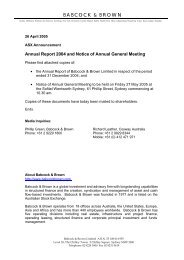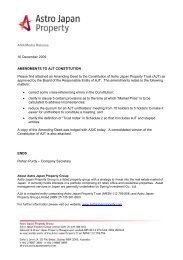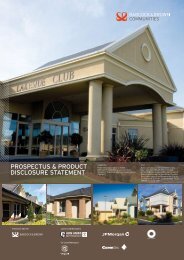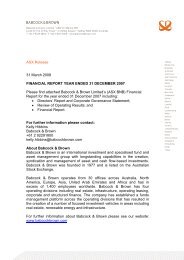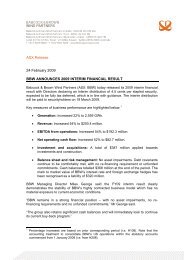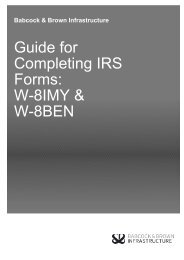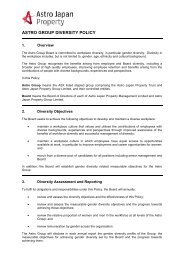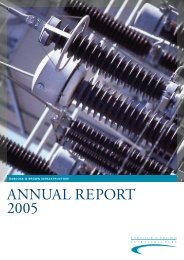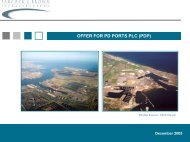Lead Manager
babcock & brown limited prospectus.pdf - Astrojapanproperty.com
babcock & brown limited prospectus.pdf - Astrojapanproperty.com
- No tags were found...
Create successful ePaper yourself
Turn your PDF publications into a flip-book with our unique Google optimized e-Paper software.
SECTION 5<br />
FINANCIAL INFORMATION<br />
5.4.4 Differences between AGAAP and Australian IFRS<br />
The differences between AGAAP and Australian IFRS identified by Babcock & Brown as potentially having a<br />
significant effect on the financial position and financial performance of Babcock & Brown are summarised below.<br />
The summary should not be taken as an exhaustive list of all of the differences between AGAAP and Australian<br />
IFRS. Further differences may be identified prior to the release of the Group’s first statutory accounts in respect<br />
of 2005. No attempt has been made to identify all disclosure, presentation or classification differences that would<br />
affect the manner in which transactions or events are presented.<br />
(a)<br />
Accounting for the Restructure of the Babcock & Brown Group – Under AGAAP, consolidated<br />
accounts are prepared by the legal parent of a group.Where, as in the case of the Babcock & Brown<br />
Restructure, a new parent entity is interposed above an existing group, that parent entity is deemed to<br />
have acquired the existing group at fair value.This triggers the recognition of (i) adjustments to<br />
recognise the net assets acquired at their fair values and (ii) goodwill in the legal parent’s consolidated<br />
accounts as the difference between the fair value of the net assets acquired and the value of the deemed<br />
consideration.<br />
Australian IFRS requires that the acquirer in a business combination be identified as the party which<br />
gains control of another.This means that in a reverse takeover situation or where an existing group is<br />
acquired by a shell company, the legal acquirer may not be the parent for the purposes of the group’s<br />
consolidated financial reporting. Specifically in the case of the Babcock & Brown Restructure,<br />
notwithstanding that BBH is acquired by BBIPL and that Babcock & Brown is the legal parent of the<br />
Group, because BBIPL and Babcock & Brown were effectively shell companies immediately prior to the<br />
Restructure, the consolidated financial statements of the Group are prepared as if BBH were the parent.<br />
As BBH was the parent of the Group immediately prior to the Restructure, under Australian IFRS it is<br />
only required to apply the rules of acquisition accounting (and hence to recognise goodwill) to those<br />
parts of the Group it did not control immediately prior to the Restructure. As these parts of the Group<br />
are relatively minor, under Australian IFRS no significant new goodwill or fair value adjustments are<br />
expected to be recognised due to the Restructure at the IPO date and no such items have been<br />
reflected in the pro-forma statement of financial position of the Babcock & Brown Group as at<br />
31 December 2003.<br />
(b)<br />
Investment properties – Under AGAAP, investment properties are typically carried at cost or market<br />
value with fair value adjustments reflected through the asset revaluation reserve. Decreases are also<br />
recognised through the asset revaluation reserve to the extent of previously recognised increments and<br />
otherwise are charged as an expense through the statement of financial performance.<br />
Under Australian IFRS, changes in the fair value of investment properties are reflected directly in profit<br />
and loss.<br />
(c)<br />
Deferred taxes – Under AGAAP the tax effect of items of income and expense that are recognised in<br />
the statement of financial performance in one period but are taxable or deductible in other years are<br />
included in the calculation of the accounting income tax expense and reflected as deferred tax assets and<br />
liabilities in the statement of financial position.<br />
Australian IFRS introduces a balance sheet method of accounting for taxation. Under this approach,<br />
deferred tax is calculated as the tax expected to be payable or recoverable on differences between the tax<br />
bases of assets and liabilities and their carrying amounts for financial reporting purposes.Therefore, if an<br />
asset was held at valuation with changes in fair value recognised in an asset revaluation reserve, no deferred<br />
tax would be recognised under AGAAP but a deferred tax liability would be recognised under Australian<br />
IFRS.<br />
128



